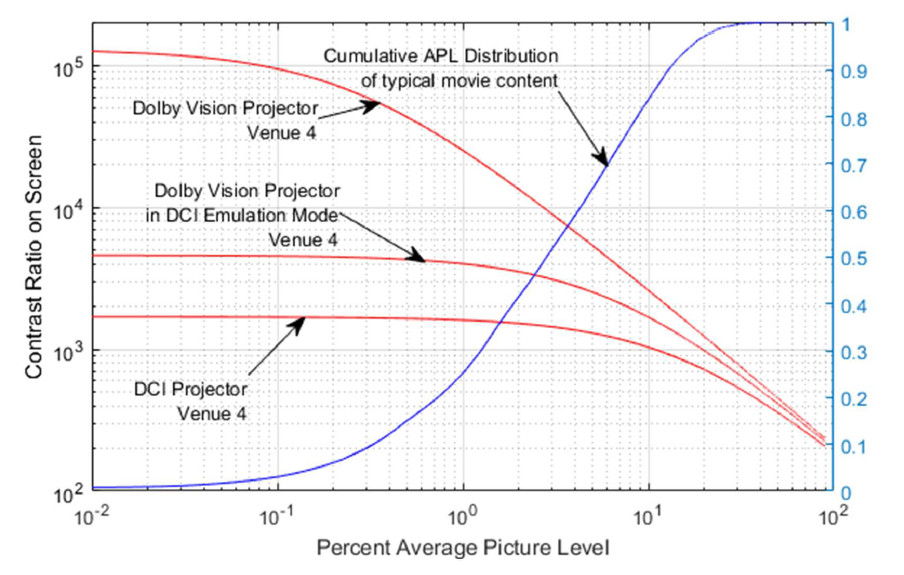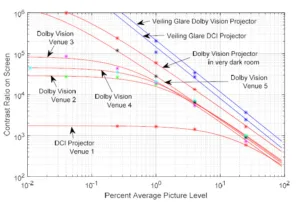Marty Richards of Dolby Laboratories presented a model for evaluating the actual contrast in a theater and then validated this model by showing data from several Dolby Vision theaters. The effort is similar to tasks undertaken previously by both Barco and RealD. (Measuring Cinema Contrast – an Update)
The ultimate contrast ratio of an image perceived by the viewer in a typical cinema depends on multiple factors. The factors associated with the projector are:
- Peak Luminance, projector (PLp)
- Dark Luminance, projector (DLp)
- Level Dependent Dark Luminance, projector (LDDLp)
The projector-dependent contrast ratio is defined as follows:
- CRp = PLp/( DLp + LDDLp)
LDDLp is associated with veiling glare, a consequence of scattering in the projection lens optics, housings, external mirrors, and port glass, and is dependent upon the luminance of the image being projected (i.e. average picture level, or APL). The veiling glare of a Dolby Vision installation (projector + mirror + port glass) at several APL’s were then measured using four-corner test patterns. It is modelled as a straight line in the chart below. The Projector Dark Level (DLp) has the greatest effect on the performance of the DCI projector, whereas the Veiling Glare has the greatest effect on the performance of the Dolby Vision projector.
One must also consider the impact of theater illumination sources like exit signs and step lights as well as reflections of light from the walls, seats and people. This latter is dependent upon the brightness (APL) of the content.
- Dark-Level Ambient Luminance, Room (DLAr)
- Level-Dependent Dark Luminance, Room (LDDLr)
Adding in the components yield a final equation for the perceived contrast ratio, which is content dependent.
- CRpr = PLp/( DLp + (VG (APLn1.26) PLp) + DLAr + (r/sg * APLn * PLp))
Where r is the normalized (to 100%) room reflectivity constant measured with an incident meter, and sg is the screen gain.
Dolby then measured five venues and plotted the data in the chart that shows the behavior with different levels of APL. The results show that the upper limit on CRpr is determined by DLp or DLAr, whichever is larger. As APL increases, the CRpr curve rolls off and CRpr becomes dependent upon LDDLp and LDDLr. For APL’s < 1%, the Dolby Vision contrast is limited by the dark level ambient luminance.
The variation in performance of the Dolby Vision theaters was mainly attributed to increased veiling glare due to dirty optics and port glass, but also room illumination sources.
Richards also looked at the APL of nine movies. The blue line below shows the histogram of the luminance on a frame by frame basis. At an APL of 10% for example, 80% of the frames were below this level. At this luminance level, contrasts of 100:1, 1800:1 and 2500:1 are achievable with the three configurations.

At lower APL levels, the benefits of the Dolby Vision cinema and the emulation mode for standard DCI content become clear in terms of contrast ratio.
In the audience Q&A, Richards was asked about the impact of reflections from the audience on contrast ratio. He said it can be significant, reducing contrast by up to about 25%. – CC

